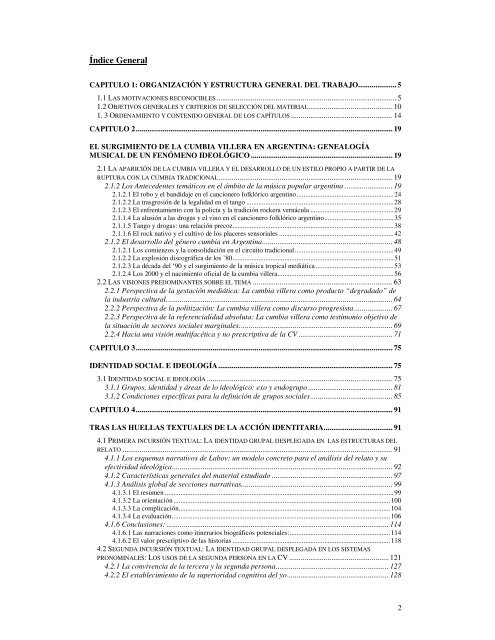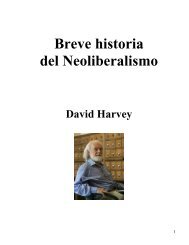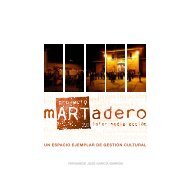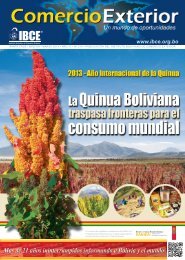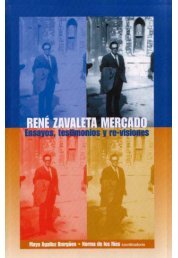Create successful ePaper yourself
Turn your PDF publications into a flip-book with our unique Google optimized e-Paper software.
Índice General<br />
CAPITULO 1: ORGANIZACIÓN Y ESTRUCTURA GENERAL DEL TRABAJO.................... 5<br />
1.1 LAS MOTIVACIONES RECONOCIBLES.............................................................................................. 5<br />
1.2 OBJETIVOS GENERALES Y CRITERIOS DE SELECCIÓN DEL MATERIAL............................................ 10<br />
1. 3 ORDENAMIENTO Y CONTENIDO GENERAL DE LOS CAPÍTULOS ..................................................... 14<br />
CAPITULO 2...................................................................................................................................... 19<br />
EL SURGIMIENTO DE LA CUMBIA VILLERA EN ARGENTINA: GENEALOGÍA<br />
MUSICAL DE UN FENÓMENO IDEOLÓGICO .......................................................................... 19<br />
2.1 LA APARICIÓN DE LA CUMBIA VILLERA Y EL DESARROLLO DE UN ESTILO PROPIO A PARTIR DE LA<br />
RUPTURA CON LA CUMBIA TRADICIONAL........................................................................................... 19<br />
2.1.2 Los Antecedentes temáticos en el ámbito de <strong>la</strong> música popu<strong>la</strong>r argentina ......................... 19<br />
2.1.2.1 El robo y el bandidaje en el cancionero folklórico argentino........................................................24<br />
2.1.2.2 La trasgresión de <strong>la</strong> legalidad en el tango .....................................................................................28<br />
2.1.2.3 El enfrentamiento con <strong>la</strong> policía y <strong>la</strong> tradición rockera vernácu<strong>la</strong> ................................................29<br />
2.1.1.4 La alusión a <strong>la</strong>s drogas y el vino en el cancionero folklórico argentino........................................35<br />
2.1.1.5 Tango y drogas: una re<strong>la</strong>ción precoz.............................................................................................38<br />
2.1.1.6 El rock nativo y el cultivo de los p<strong>la</strong>ceres sensoriales ..................................................................42<br />
2.1.2 El desarrollo del género <strong>cumbia</strong> en Argentina.................................................................... 48<br />
2.1.2.1 Los comienzos y <strong>la</strong> consolidación en el circuito tradicional.........................................................49<br />
2.1.2.2 La explosión discográfica de los ’80.............................................................................................51<br />
2.1.2.3 La década del ‘90 y el surgimiento de <strong>la</strong> música tropical mediática .............................................53<br />
2.1.2.4 Los 2000 y el nacimiento oficial de <strong>la</strong> <strong>cumbia</strong> <strong>villera</strong>...................................................................56<br />
2.2 LAS VISIONES PREDOMINANTES SOBRE EL TEMA ......................................................................... 63<br />
2.2.1 Perspectiva de <strong>la</strong> gestación mediática: La <strong>cumbia</strong> <strong>villera</strong> como producto “degradado” de<br />
<strong>la</strong> industria cultural...................................................................................................................... 64<br />
2.2.2 Perspectiva de <strong>la</strong> politización: La <strong>cumbia</strong> <strong>villera</strong> como discurso progresista .................... 67<br />
2.2.3 Perspectiva de <strong>la</strong> referencialidad absoluta: La <strong>cumbia</strong> <strong>villera</strong> como testimonio objetivo de<br />
<strong>la</strong> situación de sectores sociales marginales................................................................................ 69<br />
2.2.4 Hacia una visión multifacética y no prescriptiva de <strong>la</strong> CV ................................................. 71<br />
CAPITULO 3...................................................................................................................................... 75<br />
IDENTIDAD SOCIAL E IDEOLOGÍA........................................................................................... 75<br />
3.1 IDENTIDAD SOCIAL E IDEOLOGÍA ................................................................................................. 75<br />
3.1.1 Grupos, identidad y áreas de lo ideológico: exo y endogrupo ............................................ 81<br />
3.1.2 Condiciones específicas para <strong>la</strong> definición de grupos sociales........................................... 85<br />
CAPITULO 4...................................................................................................................................... 91<br />
TRAS LAS HUELLAS TEXTUALES DE LA ACCIÓN IDENTITARIA.................................... 91<br />
4.1 PRIMERA INCURSIÓN TEXTUAL: LA IDENTIDAD GRUPAL DESPLEGADA EN LAS ESTRUCTURAS DEL<br />
RELATO ............................................................................................................................................. 91<br />
4.1.1 Los esquemas narrativos de Labov: un modelo concreto para el análisis del re<strong>la</strong>to y su<br />
efectividad ideológica................................................................................................................... 92<br />
4.1.2 Características generales del material estudiado ............................................................... 97<br />
4.1.3 Análisis global de secciones narrativas............................................................................... 99<br />
4.1.3.1 El resumen ....................................................................................................................................99<br />
4.1.3.2 La orientación .............................................................................................................................100<br />
4.1.3.3 La complicación..........................................................................................................................104<br />
4.1.3.4 La evaluación..............................................................................................................................106<br />
4.1.6 Conclusiones: .................................................................................................................... 114<br />
4.1.6.1 Las narraciones como itinerarios biográficos potenciales:..........................................................114<br />
4.1.6.2 El valor prescriptivo de <strong>la</strong>s historias ...........................................................................................118<br />
4.2 SEGUNDA INCURSIÓN TEXTUAL: LA IDENTIDAD GRUPAL DESPLEGADA EN LOS SISTEMAS<br />
PRONOMINALES: LOS USOS DE LA SEGUNDA PERSONA EN LA CV .................................................... 121<br />
4.2.1 La convivencia de <strong>la</strong> tercera y <strong>la</strong> segunda persona........................................................... 127<br />
4.2.2 El establecimiento de <strong>la</strong> superioridad cognitiva del yo..................................................... 128<br />
2


